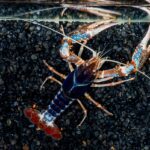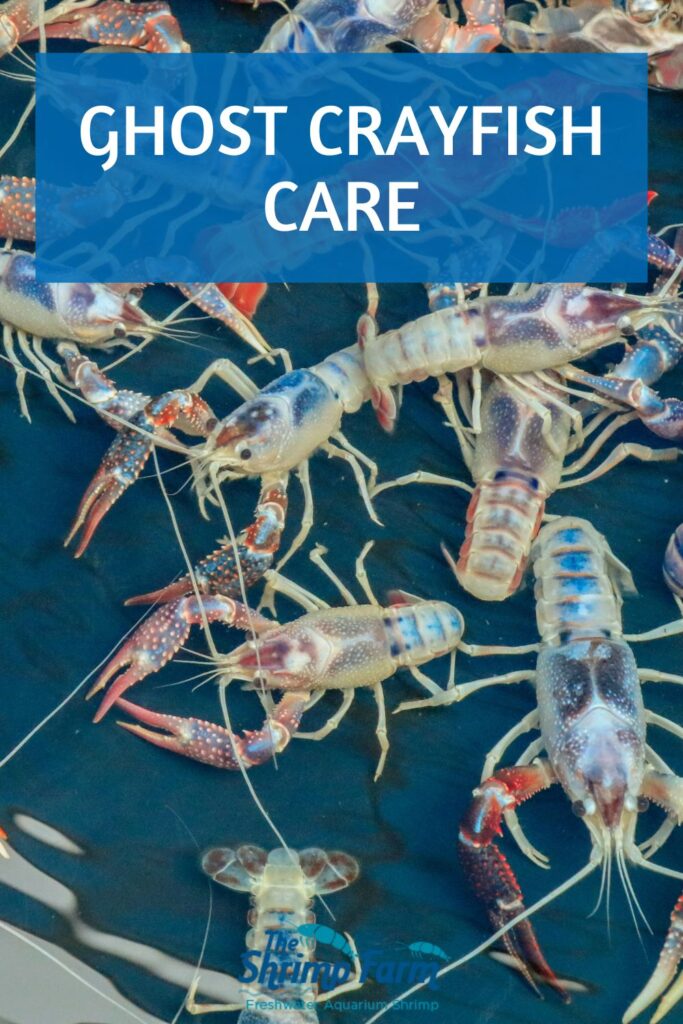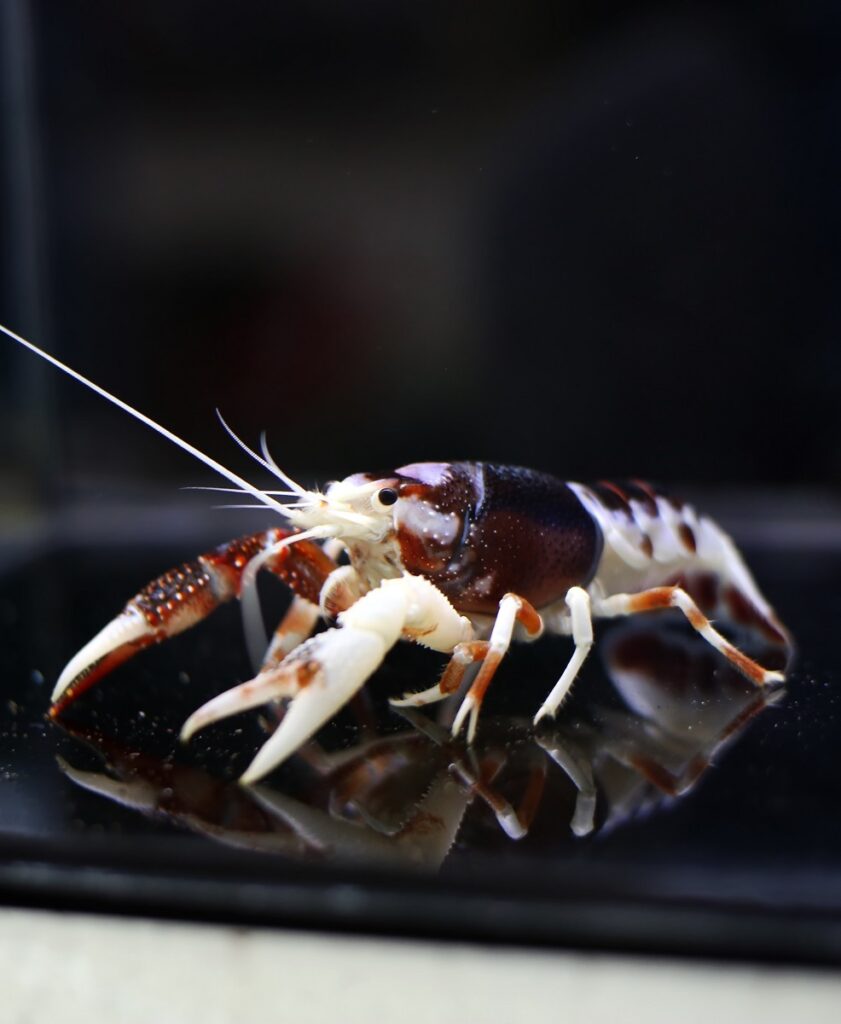Ghost Crayfish | Procambarus clarkii 'Ghost' care
Looking for something a little different for your next aquarium set-up? You may have come across the ghost crayfish, a spectacularly colored variety of the common red swamp crayfish (Procambarus clarkii). They're very nice to look at, but what do they need to thrive?
Let's go into everything you need to know about setting up a ghost crayfish aquarium and how to care for these feisty, colorful invertebrates!
| Scientific name | Procambarus clarkii 'Ghost' |
| Common names | Ghost crayfish |
| Difficulty level | Easy |
| Origin | Northern Mexico, southern USA |
Table of Contents
Ghost crayfish natural habitat & appearance
Natural habitat
Technically speaking, the ghost crayfish doesn't exist in the wild. That's because it's man-made: their patterns are the result of selective breeding for attractive color variations. This being said, the wild-colored "original" version is called Procambarus clarkii, and it's common in the northern parts of Mexico and the south(eastern) USA.
Also known as the red swamp crayfish, crawfish, crawdad or mudbug, this invertebrate can be found in pretty much any warm, slow-moving aquatic habitat you can think of. They're considered extremely hardy and can survive in stagnant, dirty waters that few other creatures can thrive in. Ditches, marshes, canals, creeks, ponds... you name it, Procambarus clarkii lives in it.
This crayfish has a few characteristics that make it particularly resistant. First off, like many other crayfish species, it has the capacity to burrow. If its habitat dries up, it just digs into the substrate below and stays there until the rainy season rolls back around. Secondly, it's able to tolerate lightly brackish (salt) water, which comes in very handy in estuaries and areas that regularly flood with seawater during storms.
Did you know? The red swamp crayfish is one of the species of crays that's commonly eaten. They're easy to catch and farm, and they're the main ingredient in a traditional crawfish boil.
Invasive potential
If you know a thing or two about crayfish, you'll be aware that all of the above taken together presents a bit of a perfect storm. Its hardiness and capacity to survive anywhere give Procambarus clarkii dangerous potential as an invasive species. You can drop a few of these crays pretty much anywhere and they'll survive and multiply, potentially causing great damage to the local ecosystem as a result.
Unsurprisingly, as with a bunch of other crays, this has already happened in some places. As discussed in multiple scientific studies, among which a comprehensive one from 2006 that looks into Procambarus clarkii's invasion of Europe, they are now the "dominant macroinvertebrate" in several countries.
Reasons for the species' rapid spread, according to this paper, include:
- Their rapid growth rate
- Early maturity
- Large numbers of offspring
- Opportunistic feeding habits
- Able to tolerate extreme environments
- Spreads "crayfish plague" which kills off native species
- Ability to adapt to different predators
You may be wondering why we're telling you all this. Well, first off, all of it is actually pretty good news for us aquarists. You clearly don't have to be an aquarium expert in order to keep one of these crayfish: they're considered practically indestructible, so they're tolerant to the occasional beginner mistake.
It also means that you should take great care to prevent your ghost crayfish from getting out into the wild. Aquarium critters should never be released, especially crayfish.
Did you know? One example of Procambarus clarkii's potential to invade pretty much any ecosystem being used in a positive manner comes from East Africa. Here, snails from the ramshorn family carry and spread parasitic flatworms that cause a disease called schistosomiasis. It was found the crayfish have a taste for these snails, thereby reducing the spread of the disease.
Appearance
Their appearance is what it's all about with ghost crayfish! Regular Procambarus clarkii crays are already quite nice to look at, with a brownish body and red extremities, but the ghosts really are something else. Their body base color is off-white rather than brown, but other than that you never know what you're going to get. Each one has different colors and patterns!
The classic "tricolor" ghost crayfish usually has a blueish head and blue to red claws and tail tip. However, they can also be cream and orange, cream and red, cream and blue and even fully white (although that's usually referred to as a White Specter). Totally blue Procambarus clarkiis are called Electric Blue crayfish.
At a maximum size of 4.5", this is definitely not a dwarf crayfish. The difference between males and females is visible if you know what to look for; they can be sexed by looking at their undersides, as males have an extra pair of swimmers.
Setting up a ghost crayfish aquarium
Requirements
One of the great things about Procambarus clarkii is that these guys are so hardy. Still, they do have some requirements that you should keep in mind if you'd like yours to thrive. For an adult ghost crayfish, due to their size, we'd recommend an aquarium of at least 20-30 gallons. It should have a hood and be well-sealed, because crayfish can escape through even the smallest holes in the tank (like those for the cables).
Crayfish naturally spend much of their day holed up in their caves, so it's important to give yours plenty of tubes and other hides to retreat into. They're nocturnal, although they can regularly be seen walking about their tank during the day as well. If you get too close to their cave, they're likely to come charging out with pincers raised!
Don't think you can turn your crayfish tank into a nice aquascape. Crays love to redecorate their environment and move stuff around. They're also ravenous for plants, decimating any but the toughest in record time. If you want a planted tank, you may have to consider going for something like the smaller CPO crayfish instead.
Lastly, your ghost crayfish will definitely appreciate a nice thick layer of soft substrate to burrow into when it feels the need.
Tip: Don't worry if your ghost crayfish suddenly becomes reclusive and temporarily loses interest in food. They molt their exoskeleton regularly as they grow, and they can be a little out of it for a few days when this happens.
Water requirements
As mentioned, Procambarus clarkii have the capacity to survive in polluted and oxygen-poor waters. However, we do recommend a fully cycled aquarium to keep yours healthy. It'll show better coloration and probably have a better lifespan if the water is nice and clean.
No special care is needed, so you can just stick to regular aquarium maintenance guidelines and perform a small water change on a weekly basis.
pH: 6.5-8
Temperature: 20-27 °C is optimum, although lower or higher should be okay.
Total Dissolved Solids: 100-500
Tankmates
Keep in mind that crayfish, particularly the males, can be quite territorial. In the wild, they're solitary creatures. You need a large aquarium if you'd like to keep multiple, just to make sure everyone gets the space they need. Fights can break out, especially in the beginning, although they should eventually establish a sort of hierarchy. Any limbs lost will be regrown over the next few molts.
When it comes to other tankmates for a ghost crayfish, your options are unfortunately rather limited. These guys are the tanks of the invertebrate world, and in many cases they'll take down whatever they can catch. We've seen them catch and eat dwarf shrimp, so that's definitely out of the question.
Some aquarists have had success with small, quick schooling fish like Danios as tankmates for their ghost crayfish. This being said, we personally prefer a single-species set-up for our crayfish just to eliminate any chance of issues. They will go for fish if they have the chance.
Ghost crayfish diet
Procambarus clarkii crayfish are opportunistic omnivores. They'll eat pretty much anything that's presented to them! In the wild, they were found to mainly feed on animal matter, though individuals examined in a 2003 study also had plenty of plants and detritus in their stomachs. The juveniles ate more meat, while the adults had more of a taste for plants.
Based on this, keeping your ghost crayfish well-fed in the aquarium should be a breeze. Just offer a range of different foods and you're golden! Include plenty of stuff that's rich in nutrients and vitamins to keep your cray looking vibrant.
You can give plant-based shrimp food, which contains plenty of calcium to help with molting. Color-enhancing brands may be a good choice. Other than this, normal fish foods, blanched veggies, frozen fish foods and even live foods (if you happen to have them on hand) should work fine.
Crayfish can be messy eaters. Be sure to remove any excess or leftover foods from the tank within a few hours to prevent it from polluting the water.
Breeding ghost crayfish
Ever seen two crayfish mate? To be honest, sometimes it's difficult to tell whether they're squabbling over territory or dancing the horizontal tango! Basically, when two ghost crayfish meet, they will be able to tell whether the other is male or female by means of vision, posture and pheromones. The latter they detect with their antennules (the shorter antennae on their head).
Once it has been confirmed that the new crayfish is not an intruder but a potential mate, the male will turn the female over and the two lock in an embrace. Once it's all over, the female moves eggs (sometimes hundreds!) from her ovaries to her swimmers. She can carry them for weeks or months depending on water temperature.
Once the young hatch, they remain in mom's swimmers for little while longer. After this, they'll finally go out into the wide world, at which point it may be handy to separate them from their mother if you'd like for them to survive long-term. Other than this, they're easy to keep alive and rear.
Buying ghost crayfish
When ghost crayfish were first introduced into the US aquarium market, they made quite a stir. Not surprising given those colors! They were marketed as a rare color morph and prices were quite high.
Nowadays you're still unlikely to come across these crayfish at your local aquarium store, but they have gotten a bit easier to find. You should probably be able to order a small specimen online for under $30.
Frequently asked questions
Procambarus clarkii crayfish can live for five years, or even more with the right care.
Absolutely not! Ghost crayfish actively hunt fish and will have no problem snagging a slow-moving Betta fish.



 Shrimp
Shrimp Fish
Fish Crab &
Crab & Plants
Plants Foods
Foods Snails
Snails


